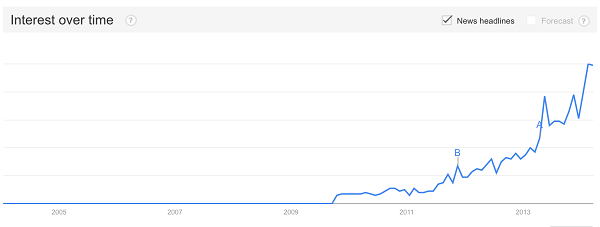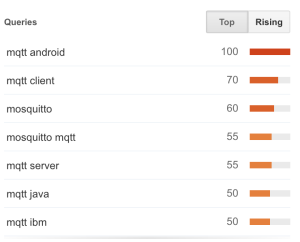Internet of Things-protocol MQTT on the rise
A common language between things is one of the most critical aspects in enabling even the most basic of the “Internet of Things”-visions. MQTT (MQ Telemetry Transport) is rapidly taking gaining momentum as that language.
MQTT is “a publish/subscribe, extremely simple and lightweight messaging protocol, designed for constrained devices and low-bandwidth, high-latency or unreliable networks.”, in other words a language which is suited for allowing things to connect and communicate. MQTT is not new. It’s been around since 1999, invented Dr Andy Stanford-Clark of IBM, and Arlen Nipper of Arcom (now Eurotech). For many years, it’s been waiting in the shadows, enabling a few M2M-solutions (machine to machine). But now it seems it’s just about to take off in a major way.
One of the simpler ways of assessing popularity is to use Google Trends which generates a chart based on how often a term is searched for. Below is the chart for “MQTT”.
Another supporting indicator that MQTT is starting to mean more than it did just a couple of years ago is revealed by looking at what other search terms is used in combination with MQTT (android, client, mosquitto…):
Many of the tools, frameworks and APIs that I mentioned in my post “Internet of Things development tools and framework” implement support of MQTT, including Mosquitto which is a message broker (like FedEx, UPS, DHL…) for MQTT.
IBM is investing significantly in MQTT, Facebook uses the protocol in its messaging app and it’s in the process of undergoing standardisation at OASIS. The IBM related investments include support in their MessageSight appliance, reported to be able to manage more than ten million MQTT messages per second coming from a million “things”.
More information
- Do you want to stay updated regarding the inner workings of the Internet of Things, relevant protocols and platforms, you will find the “Wireless Sensors Blog” extremely valuable.
- Do you want to deep dive into this old-new technology? Download the latest MQTT specification and any of the APIs implementing it, and start experimenting: MQ Telemetry Transport (MQTT) V3.1 Protocol Specification


